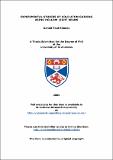Files in this item
Experimental studies of cold atom guiding using hollow light beams
Item metadata
| dc.contributor.advisor | Dholakia, Kishan | |
| dc.contributor.author | Rhodes, Daniel Paul | |
| dc.coverage.spatial | xx, 285 p. | en_US |
| dc.date.accessioned | 2018-03-13T16:43:02Z | |
| dc.date.available | 2018-03-13T16:43:02Z | |
| dc.date.issued | 2005 | |
| dc.identifier.uri | https://hdl.handle.net/10023/12932 | |
| dc.description.abstract | This thesis is concerned with the guiding of cold atoms using optical forces, which is of great importance in the field of atom optics. Atomic beams can be used for precision sensor equipment, building nano-scale structures, construction of quantum computers and to further the understanding of the properties of atoms. Atoms are guided along light beams using the dipole force; there are two regimes under which this force works. Typically red-detuned guides are used (atoms are attracted towards the light) such guides, however, require large detuning and high powers. In this thesis we investigate the use of blue-detuned (atoms are repelled from the light) hollow light beams of moderate power (a few hundred mW) and confine atoms in the dark centre of the beams. Several magneto-optical traps (MOTs) have been constructed to exploit different guiding geometries. Hollow beams have been generated using a variety of methods; in particular the use of a computer controlled spatial light modulator (SLM) has provided great versatility and simplicity to the experimental arrangements. First, experiments were performed with a low-velocity intense source (LVIS) of atoms. A co-linear LG beam significantly enhances the observed flux, however, considerable difficulties are encountered loading atoms into oblique guides. Imaging a hole in the walls of the light tube was used to improve the loading efficiency. Second, guiding a free-falling atom cloud is performed using a non-diffracting Bessel beam. It is found that while the potential of the Bessel beam is steeper than equivalent LG beams the power distribution across the beam severely limits its usefulness. The next study investigated higher-order LG guide beams generated with an SLM. High order modes have a narrower profile so confine the atoms with less interaction with the guide beam, leading to a more natural guide (as opposed to a pushing force). Finally the SLM was used to create non-trivial beam shapes for beam splitters and interferometers. | en_US |
| dc.language.iso | en | en_US |
| dc.publisher | University of St Andrews | |
| dc.subject.lcc | QC173.4A85R5 | |
| dc.subject.lcsh | Atomic beams. | en |
| dc.subject.lcsh | Laser cooling. | en |
| dc.subject.lcsh | Magnetooptical devices. | en |
| dc.subject.lcsh | Light modulators. | en |
| dc.subject.lcsh | Beam splitters. | en |
| dc.subject.lcsh | Optical interferometers. | en |
| dc.title | Experimental studies of cold atom guiding using hollow light beams | en_US |
| dc.type | Thesis | en_US |
| dc.type.qualificationlevel | Doctoral | en_US |
| dc.type.qualificationname | PhD Doctor of Philosophy | en_US |
| dc.publisher.institution | The University of St Andrews | en_US |
This item appears in the following Collection(s)
Items in the St Andrews Research Repository are protected by copyright, with all rights reserved, unless otherwise indicated.

